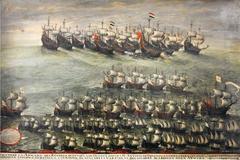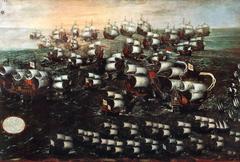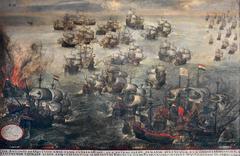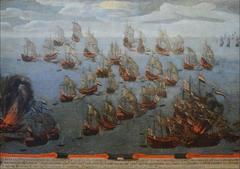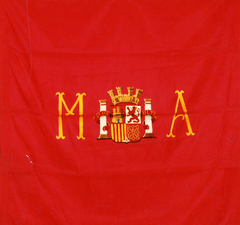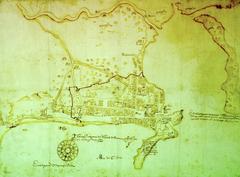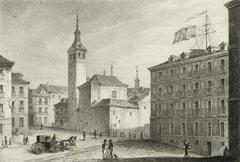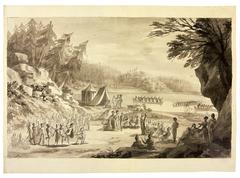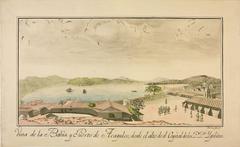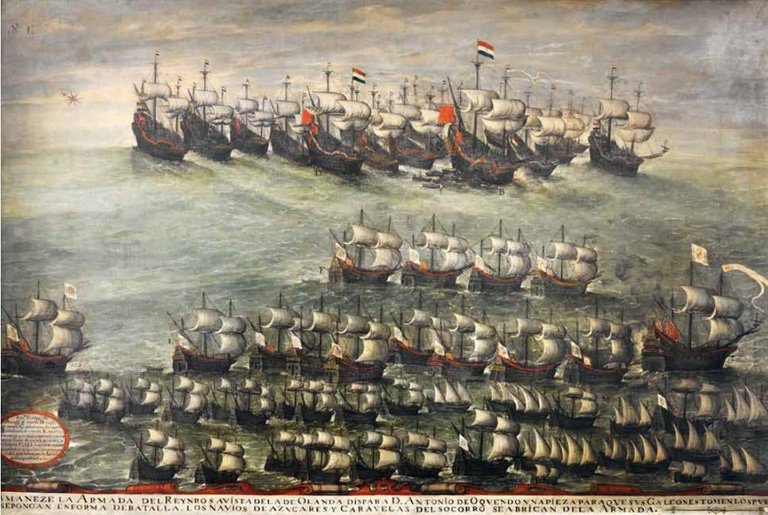
Naval Museum of Madrid: Visiting Hours, Tickets, and Guide to Madrid Historical Sites
Date: 14/06/2025
Introduction
The Naval Museum of Madrid (Museo Naval de Madrid) stands at the heart of Spain’s cultural capital, offering an unparalleled journey through the nation’s maritime achievements. Located on Paseo del Prado within Madrid’s famed “Art Walk,” this museum is an essential destination for those seeking to understand Spain’s profound impact on world exploration, trade, and naval warfare. Home to more than 10,000 artifacts—including the iconic 1500 world map by Juan de la Cosa—the Naval Museum seamlessly blends historic grandeur with modern visitor amenities, making it one of the most fascinating Madrid historical sites (Museo Naval - Spanish Navy).
This comprehensive guide covers the museum’s history and significance, highlights from its world-class collections, practical visitor information, accessibility details, and recommendations for combining your visit with nearby attractions in Madrid’s cultural heart.
1. Historical Background and Significance
Origins and Establishment
The idea for the Naval Museum of Madrid originated with King Ferdinand VII’s royal decree in 1792, though the museum officially opened its doors in 1843. Initially housed in the Ministry of the Navy, it later moved to its current residence within the Spanish Navy Headquarters building in 1932. This historic setting, itself a recognized architectural landmark, provides a fitting backdrop for Spain’s rich seafaring legacy (Museo Naval - Spanish Navy).
Spain’s Maritime Heritage
The museum chronicles Spain’s rise as a maritime superpower, from the Age of Discovery to modern times. Exhibits detail the Spanish Navy’s critical role in global exploration, the expansion of the Spanish Empire, and its participation in pivotal naval conflicts. The institution also serves as a research center, fostering collaborations with historians and international museums (Museo Naval - Official Site).
2. Notable Collections and Artifacts
Cartography and Navigation
A highlight of the museum is the 1500 world map by Juan de la Cosa, the oldest known map to depict the Americas. The collection also includes rare nautical charts, globes, and navigation instruments, showcasing the innovation that fueled Spain’s global explorations (Juan de la Cosa Map - Museo Naval).
Ship Models and Figureheads
Hundreds of ship models—ranging from 15th-century caravels to the mighty 18th-century Santísima Trinidad—demonstrate the evolution of naval engineering. Decorative figureheads and detailed replicas offer both technical and artistic perspectives.
Weapons, Uniforms, and Personal Effects
The museum’s armory includes cannons, swords, and firearms from different eras. Uniforms, medals, and the personal effects of prominent naval figures such as Admiral Blas de Lezo and Admiral Gravina add a human dimension to the naval story (Museo Naval - Collections).
Art and Maritime Culture
Paintings, engravings, sculptures, and ethnographic objects illustrate everyday life at sea and the broader cultural context of Spain’s maritime history.
3. Museum Layout, Thematic Structure, and Exhibits
Layout
The museum is spread across 24 exhibition halls arranged mostly chronologically, with thematic rooms dedicated to navigation, weaponry, shipbuilding, and art. Stained-glass ceilings, crafted by the Maumejean family, and a modernist façade add to the ambiance (Wikipedia). Clear signage, printed maps, and multilingual audio guides facilitate self-guided tours (GPSmyCity).
Thematic Structure
- Chronological Galleries: From the Catholic Monarchs and the Age of Discovery through the Spanish Empire, 19th-century modernization, and contemporary naval operations.
- Specialized Sections: Navigation instruments, personal artifacts, decorative arts, ship models, and weapons.
Key Exhibits
- Juan de la Cosa’s World Map (1500)
- Model of the Santísima Trinidad
- Artifacts from the Battle of Trafalgar
- Manila Galleons Collection (Manila Galleons - Museo Naval)
- Interactive navigation simulators
4. Visitor Information
Location and Access
- Address: Paseo del Prado, 5, 28014 Madrid
- Metro: Banco de España (Line 2)
- Bus: Numerous routes serve the area
- BiciMAD: Nearby docking stations
Visiting Hours
- Tuesday to Sunday: 10:00 – 19:00 (August: 10:00 – 15:00)
- Closed: Mondays, January 1 & 6, May 1, July 16, December 24, 25, and 31 (esmadrid.com)
Tickets and Admission
- Entry: Free (suggested voluntary donation of €3)
- Tickets: Available on-site or online. Advance booking is recommended during peak times (introducingmadrid.com).
Guided Tours and Special Events
- Free Guided Tours: With reservation, Tuesday–Friday at 10:00, 12:30, and 16:00. English tours may be available—book in advance.
- Educational Programs: Workshops for families and schools, and temporary exhibitions.
- Virtual Tour: Available via the official website (museumsexplorer.com).
Facilities
- Restrooms: Accessible toilets available
- Shop: Books, souvenirs, and maritime gifts
- Cloakroom: For large bags and backpacks
5. Accessibility
Physical Accessibility
The museum is adapted for visitors with reduced mobility. Lifts connect all floors, accessible restrooms are available, and wheelchairs can be borrowed (esmadrid.com).
Visual and Language Accessibility
- Braille signage: On lift buttons
- Exhibit labels: Primarily in Spanish, with increasing English translations
- Guided tours: English available with advanced booking
6. Visitor Tips and Peak Times
- Arrive early or late in the day to avoid crowds, especially on weekends and holidays.
- Allow at least 1.5–2 hours for your visit.
- Use the official website and social media for updates on visiting hours, events, and accessibility.
- Photography is permitted in most areas (no flash/tripods).
7. Nearby Attractions and Cultural Context
Golden Triangle of Art
The Naval Museum is steps away from Madrid’s most prestigious museums:
- Prado Museum: Spanish and European masterpieces
- Thyssen-Bornemisza Museum: Art from Renaissance to modern
- Reina Sofía Museum: Modern art including Picasso’s “Guernica”
Other nearby landmarks include Cibeles Palace, Plaza de Cibeles, Neptune Fountain, Retiro Park, and Gran Vía (Madridista Forever; Timeout Madrid).
Dining and Leisure
A range of restaurants, tapas bars, and cafes are found along Paseo del Prado, with outdoor terraces ideal for relaxing after your museum visit (Global Highlights).
Seasonal Events
June brings open-air concerts, cultural festivals, and extended museum hours. The San Isidro Fair and other summer events add to the area’s vibrancy (Madrid Traveller).
8. Frequently Asked Questions (FAQ)
Q: What are the Naval Museum of Madrid visiting hours?
A: Tuesday to Sunday, 10:00–19:00 (August: 10:00–15:00). Closed Mondays and select holidays.
Q: How much is admission?
A: Entry is free, with a suggested donation of €3.
Q: Can I book tickets online?
A: Yes, tickets are available online or at the museum. Advance booking is recommended for peak times.
Q: Are guided tours available in English?
A: Yes, with advance reservation.
Q: Is the museum accessible for visitors with disabilities?
A: Yes, with adapted spaces, lifts, and accessible restrooms.
Q: Does the museum offer virtual tours?
A: Yes, via the official website.
9. Visuals and Media Suggestions
- High-quality images of the museum’s façade, Juan de la Cosa map, ship models, and stained-glass ceilings.
- Alt tags: “Naval Museum of Madrid ship models,” “Naval Museum of Madrid visiting hours,” “Juan de la Cosa world map.”
- Interactive maps and links to the virtual tour are recommended.
10. Summary and Final Recommendations
The Naval Museum of Madrid offers a comprehensive and engaging exploration of Spain’s maritime history, enhanced by recent renovations and a prime location within Madrid’s cultural district. Entry is free, and the museum’s exhibits—ranging from ship models and navigation tools to art and manuscripts—make it a highlight for visitors of all ages and interests (Museo Naval - Collections). Combine your visit with other world-class attractions nearby, and consider booking a guided tour for deeper insight.
For the latest updates and to plan your visit, check the official museum website, and download the Audiala app for audio guides and interactive content. Stay connected through social media for event news and tips.
References
- Museo Naval - Spanish Navy
- Museo Naval - Official Site
- Museo Naval - Collections
- Juan de la Cosa Map - Museo Naval
- Manila Galleons - Museo Naval
- Madridista Forever
- esmadrid.com
- introducingmadrid.com
- Wikipedia
- GPSmyCity
- museumsexplorer.com
- Flip Flops Included
- Condé Nast Traveler
- Timeout Madrid
- Ticket Madrid
- Global Highlights
- Madrid Traveller
